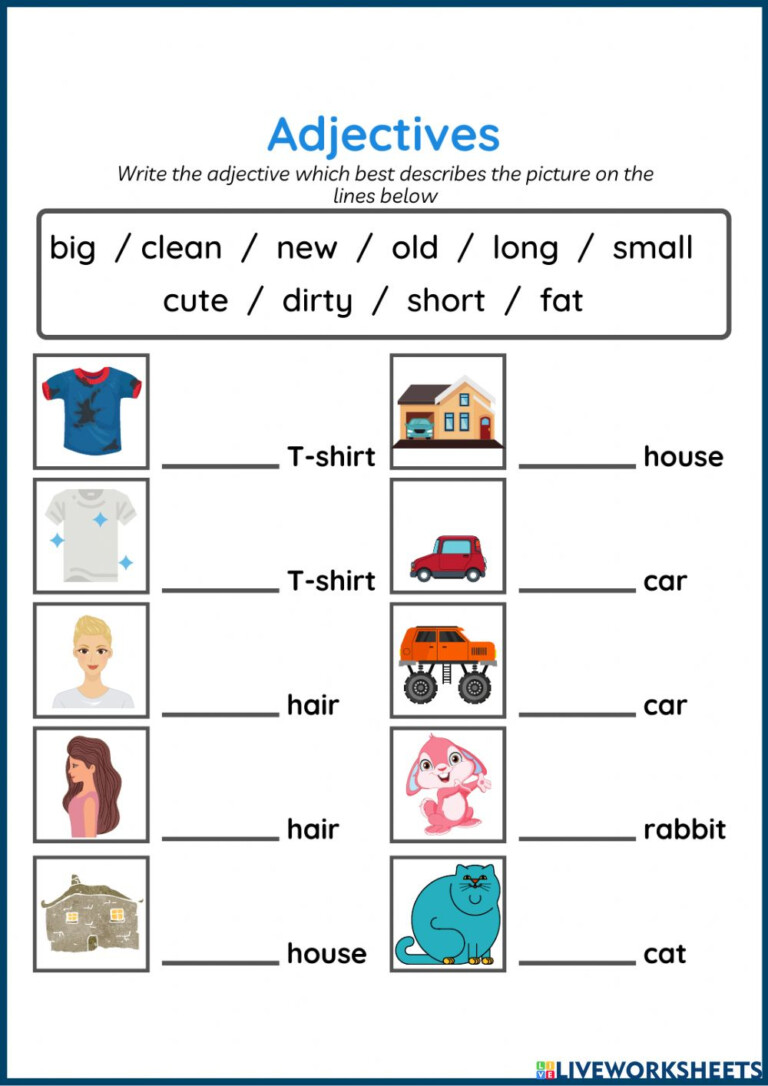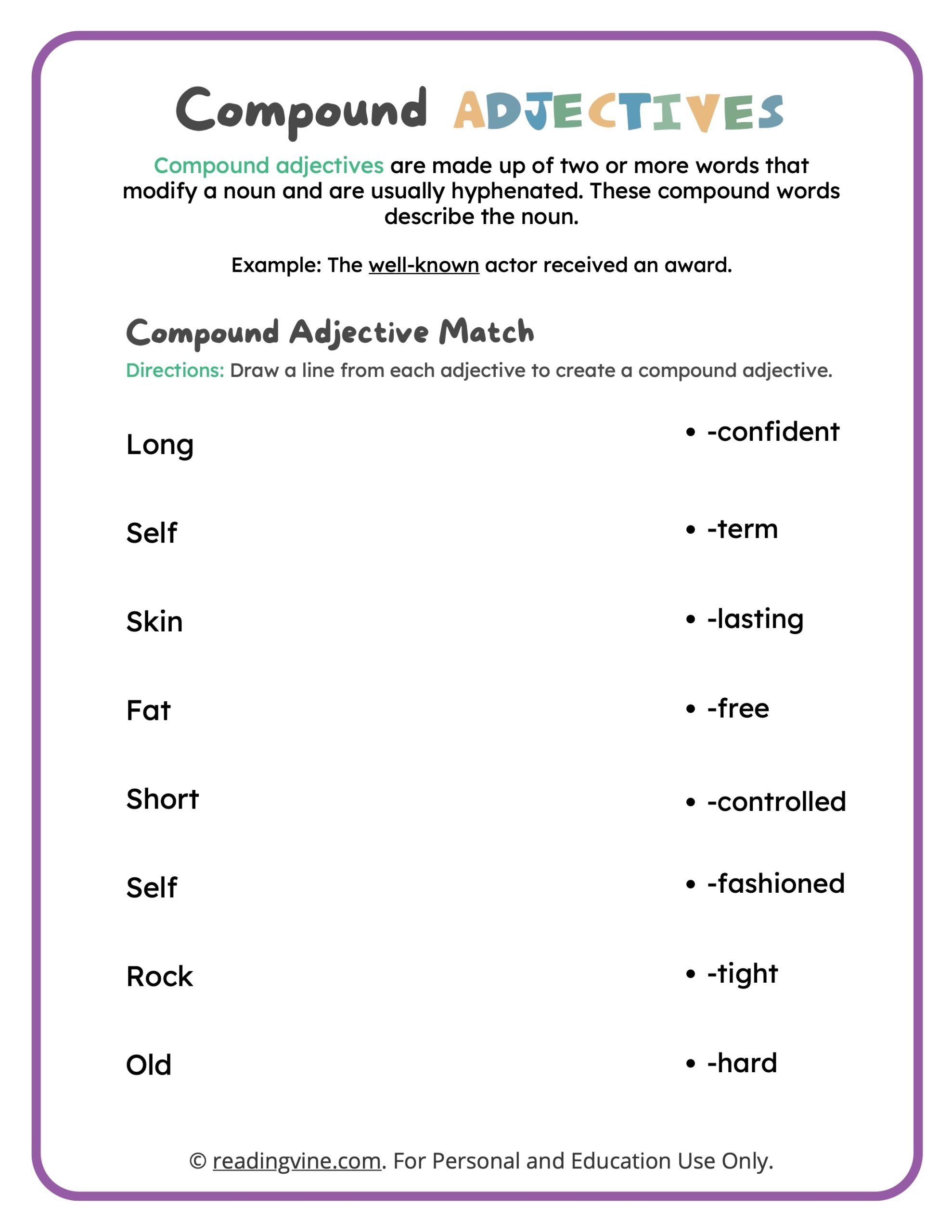
Unlocking Descriptive Power: The Comprehensive Guide to Adjective Matching Activities
Adjectives are the vibrant hues in the palette of language, transforming mundane descriptions into vivid imagery and precise communication. They allow us to differentiate, to qualify, and to infuse our words with emotion and detail. However, for language learners of all ages, mastering the nuanced world of adjectives can be a significant hurdle. Understanding their meaning is one thing; using them appropriately and effectively in context is another entirely. This is where the adjective matching activity emerges as an exceptionally powerful and versatile pedagogical tool.
From elementary classrooms to advanced language acquisition programs, the adjective matching activity provides a structured, engaging, and highly effective way to build vocabulary, reinforce grammatical concepts, and cultivate a deeper appreciation for the descriptive power of language. This comprehensive guide will delve into the profound benefits, diverse variations, effective design principles, and practical implementation strategies for integrating adjective matching activities into any learning environment.
The Indispensable Role of Adjectives in Language

Before exploring the mechanics of matching, it’s crucial to acknowledge why adjectives hold such importance. Adjectives modify nouns or pronouns, providing information about their qualities, states, or characteristics. They answer questions like "What kind?", "Which one?", or "How many?". Without them, our language would be flat, generic, and uninspiring. Consider the difference between "a car" and "a sleek, red, vintage sports car." The adjectives transform a simple object into a specific, appealing image.

For language learners, adjectives present several challenges:

- Vocabulary Acquisition: There are countless adjectives, many with subtle differences in meaning (e.g., happy, joyful, gleeful).
- Contextual Use: An adjective might be appropriate in one context but not another (e.g., tall building vs. tall person).
- Placement and Agreement: In English, adjectives typically precede the noun they modify, but in other languages, placement and agreement rules can be complex.
- Nuance and Connotation: Adjectives carry emotional weight and cultural connotations that learners must grasp.


The adjective matching activity directly addresses these challenges by providing a focused, interactive, and often visual approach to learning.

What is an Adjective Matching Activity?
At its core, an adjective matching activity involves pairing an adjective with a related word, image, definition, or concept. This seemingly simple task engages multiple cognitive processes, fostering deeper learning than mere rote memorization. It moves beyond simply recognizing an adjective to understanding its appropriate application.

The basic premise is to present a list of adjectives and another corresponding list (e.g., nouns, synonyms, antonyms, definitions, or images) and have learners draw lines, connect cards, or drag and drop elements to form correct pairs. The power lies in its adaptability, allowing educators to tailor the complexity and content to suit specific learning objectives and proficiency levels.
The Multifaceted Benefits of Adjective Matching Activities

The widespread adoption of adjective matching activities in language education is not accidental; it stems from a rich array of pedagogical benefits:
- Vocabulary Expansion and Reinforcement: This is perhaps the most obvious benefit. Learners are directly exposed to new adjectives and their associated meanings or applications. Repeated exposure through matching helps solidify new vocabulary in long-term memory.
- Contextual Understanding: Instead of learning adjectives in isolation, learners see them in relation to the nouns or concepts they describe. This contextualization is crucial for meaningful acquisition. For instance, matching "fluffy" with "cloud" or "cat" helps cement the meaning more effectively than a dictionary definition alone.
- Grammar Reinforcement: While not explicitly a grammar lesson, matching adjectives with nouns subtly reinforces the grammatical rule of adjective placement before the noun in English.
- Development of Critical Thinking and Nuance: As activities become more complex, learners must consider subtle differences between synonyms (e.g., big vs. enormous vs. colossal) or choose the best adjective from a set of plausible options, fostering higher-order thinking skills.
- Engagement and Motivation: The game-like nature of matching activities makes learning enjoyable. It provides immediate feedback, which can be highly motivating, especially for younger learners or those who struggle with traditional exercises.
- Accessibility and Differentiation: Adjective matching activities can be easily adapted for learners with diverse needs and learning styles. Visual learners benefit from image-based matching, while kinesthetic learners might enjoy physical card sorting. The difficulty can be scaled from basic to advanced by varying the vocabulary and the complexity of the relationships.
- Formative Assessment Tool: Educators can quickly gauge student understanding of specific adjectives or concepts by observing their performance in a matching activity. This provides valuable immediate feedback for both the teacher and the learner.
- Versatility Across Skill Levels: From introducing basic colors and shapes to kindergarteners to exploring complex literary adjectives with advanced students, the activity format remains relevant and effective.

Diverse Types and Variations of Adjective Matching Activities
The beauty of the adjective matching activity lies in its incredible versatility. Here are some popular variations:
- Adjective-Noun Matching: The most fundamental type. Learners match adjectives (e.g., red, tall, happy) with appropriate nouns (e.g., apple, tree, child). This can be done with words, pictures, or a combination.
- Adjective-Image Matching: Particularly effective for visual learners and beginners. Learners match adjectives with corresponding images (e.g., sparkling with a picture of a diamond, gigantic with a picture of an elephant).
- Adjective-Definition Matching: For more advanced learners, this involves matching an adjective with its dictionary definition (e.g., ubiquitous with "found everywhere"). This challenges comprehension and precise understanding.
- Adjective-Synonym/Antonym Matching: This variation enhances vocabulary depth. Learners match an adjective with a word that has a similar meaning (synonym, e.g., brave – courageous) or an opposite meaning (antonym, e.g., hot – cold).
- Adjective-Sentence Completion: Learners choose the best adjective to complete a sentence (e.g., "The __ cat purred softly." – options: fluffy, rough, sharp). This directly applies the adjective in context.
- Adjective-Category Matching: Learners group adjectives under thematic categories (e.g., "describing food" – delicious, spicy, sweet; "describing emotions" – angry, sad, elated).
- Adjective-Cause/Effect Matching: A more advanced variation where learners match an adjective describing a state with its potential cause or effect (e.g., exhausted – "after running a marathon"; thrilled – "winning the lottery").
- Technology-Enhanced Matching: Digital platforms like Quizlet, Kahoot, Google Forms, or interactive whiteboard software allow for dynamic drag-and-drop, click-and-match, or multiple-choice matching activities, often with gamified elements and instant feedback.
Designing Effective Adjective Matching Activities
Creating an impactful adjective matching activity requires thoughtful planning:
- Define Learning Objectives: What specific adjectives do you want learners to acquire or reinforce? What skill are you targeting (e.g., basic recognition, nuanced understanding, contextual application)?
- Select Appropriate Vocabulary: Ensure the adjectives and their corresponding matches are suitable for the learners’ proficiency level and relevant to the current unit or theme. Introduce a manageable number of new words per activity.
- Choose the Right Format: Will it be physical cards, a worksheet, an interactive whiteboard activity, or an online quiz? Consider your learners’ access to technology and preferred learning styles.
- Provide Clear and Concise Instructions: Learners should understand exactly what they need to do.
- Include Distractors (Strategically): To make the activity challenging and prevent guessing, include extra adjectives or nouns that don’t have a match, or include plausible but incorrect matches that require careful thought.
- Vary the Difficulty: Start with simpler, more direct matches and gradually introduce more complex relationships, synonyms, or nuanced choices as learners progress.
- Incorporate Visuals: Images are incredibly powerful for vocabulary acquisition, especially for beginners and visual learners.
- Consider Scaffolding: For challenging activities, provide hints, examples, or allow collaboration.
- Make it Relevant and Engaging: Connect the adjectives to real-world scenarios, character descriptions, or topics of interest to the learners.
Implementing Adjective Matching Activities in the Classroom
Once designed, the implementation of an adjective matching activity can be varied to maximize engagement and learning outcomes:
- Warm-up/Cool-down: A quick matching activity can serve as an excellent warm-up to review previously learned adjectives or a cool-down to consolidate new vocabulary at the end of a lesson.
- Main Activity:
- Individual Work: Learners complete worksheets or digital activities independently.
- Pair Work: Students collaborate to match, discussing their choices and justifying their reasoning, which promotes speaking practice.
- Small Group Competition: Turn it into a race or a game where groups compete to correctly match the most pairs, fostering a fun, competitive spirit.
- Whole-Class Interactive: Using an interactive whiteboard, students can come up to match words, or the teacher can lead a collaborative matching session.
- Differentiated Instruction:
- Support Struggling Learners: Provide fewer options, more obvious matches, or pre-teach key vocabulary. Allow them to use dictionaries or collaborate.
- Challenge Advanced Learners: Introduce more abstract adjectives, require them to justify their choices verbally or in writing, or have them create their own matching activities for peers.
- Feedback and Discussion: After the activity, always review the answers as a class. Discuss why certain matches are correct and why others are incorrect. Encourage learners to explain their reasoning, reinforcing their understanding. This is where the deeper learning often occurs.
- Integration with Other Skills: Don’t let the matching activity stand alone. Follow it up by having students:
- Use the matched pairs in sentences.
- Write a short paragraph describing an object or person using the new adjectives.
- Create a story incorporating several of the adjectives.
- Describe an image or a character using the learned vocabulary.
Beyond the Match: Extending Learning
The adjective matching activity is a fantastic starting point, but its true power is unleashed when it serves as a springboard for further linguistic exploration. After successfully matching adjectives, encourage learners to:
- Create Descriptive Sentences: "The fluffy cat purred."
- Write Short Descriptive Paragraphs: "The ancient castle stood on a craggy hill, its crumbling walls whispering forgotten tales."
- Engage in Oral Description: Ask students to describe a picture, a person, or an object using as many new adjectives as possible.
- Play "Guess the Word": One student thinks of a noun and describes it using adjectives; others guess the noun.
- Adjective Charades/Pictionary: Students act out or draw an adjective for others to guess.
- Self-Correction and Peer Feedback: Encourage students to identify and correct adjective misuse in their own or their peers’ writing/speaking.
Conclusion
The adjective matching activity is far more than a simple vocabulary exercise; it is a dynamic, adaptable, and highly effective pedagogical tool for fostering a deep and nuanced understanding of adjectives. By engaging learners in active word association, critical thinking, and contextual application, these activities pave the way for more precise, vivid, and impactful communication. Whether used as a quick warm-up, a core lesson component, or a formative assessment, the adjective matching activity empowers learners to unlock the full descriptive potential of the English language, transforming them from passive recipients of vocabulary into active, articulate communicators. Embracing this versatile approach can significantly enhance vocabulary acquisition, grammar reinforcement, and overall linguistic fluency for learners at every stage of their language journey.
